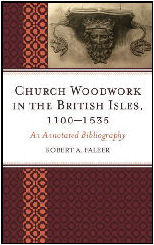| |
|
 |
|
An annotated
bibliography is a rich dish. Here,
condensed into 450 pages, are the fruits
of a lifetime's reading of one passionate
and academic historian. Rob Faleer's Church
Woodwork in the British Isles 1100-1535:
an Annotated Bibliography is a new
volume from Scarecrow
Press which
catalogues and describes almost a
thousand books, journals and articles
which he has read and found useful, and
which shed light on the wooden fixtures,
fittings and furnishings of medieval
churches from shortly after the Norman
conquest up until the English Protestant
Reformation. This is an enormous body of
work, covering a wide subject area over
more than four hundred years of history
which, furthermore, form the single
greatest extended period in English
artistic endeavour. At the start of this
outstanding contribution to English
church studies, Rob Faleer, who is
reference librarian at Central Michigan
University, tells us that his intention
is to capture the spirit of each work
and at the very least to provide a sense
of their author's intent. Of course,
he does rather more than that. Faleer's
work is a carefully organised selection
of hundreds of reviews of books going
back over several hundred years. A
typical entry is several hundred words in
length, and allows us to judge the
usefulness of the work in question; but
also teaches us something of what we
might learn within its pages, and
entertains us in doing so. This is not a
dry book: Faleer is a confident and
interesting writer. Where a reviewed work
is a gazeteer or guide, he makes clear
the scope and depth of the survey. If the
book in question is a piece of historical
research, he is able to explain the
argument of the work and the evidence
used to support it. This makes Church
Woodwork an enjoyable book to dip
into - I learn from Faleer's review, for
example, about the research into and
theories about the construction and
painting of the famous Thornham retable
at Thornham Parva in Suffolk. I now know
something of the history of medieval bell
frames, and of the research into the
origins of the medieval wooden crucifix
at Kemeys (Monmouthshire), without having
to read the reviewed works. There is even
room for anecdotes which might capture
the imagination, such as that the panels
of the Bunbury (Cheshire) rood screen
were discovered being used in a cellar
for storing potatoes!
|
Perhaps most poignant are
the reviews of older books and journals about
churches and features now lost to us, such as
those in Coventry Cathedral and the church of St
Nicholas at Great Yarmouth in Norfolk, both
destroyed in the Blitz in the Second World War.
It would, of course, be
possible to publish a mere bibliography without
reading many the works concerned to any great
depth. Not so an annotated bibliography, and
Church Woodwork shows evidence of
breathtakingly extensive reading. The text is
carefully organised into seven themes: Furnishings
of the Choir; Furnishings of the Presbytery;
Furnishings of the Nave; Structural Woodwork;
Screens, Roods and Rood-Lofts; Tomb Fixtures,
Statues and Movable Furnishings, and Transplanted
Continetal Church Furnishings and Altarpieces.
Each theme is then further sub-divided into
sections - for example, the chapter on Structural
Woodwork has collections of reviews of books
about Roofs and Timber Vaulting, Ceiling and
Roof Paintings and Tower and Spire
Framing and Fittings. All this would be
useful and interesting in itself, but in addition
there are three exhaustive indexes, of authors,
locales and subjects. I found it very easy indeed
to look up churches in which I was specifically
interested, types of furnishings that I wanted to
know more about, and authors whose work I knew
and wanted to discover other books they might
have written. I have to say that this book will
be of particular interest to people with a love
of the churches of East Anglia, which provide a
reasonable proportion of the subject matter of
the works reviewed, and are obviously a
particular love of Rob Faleer.
Feasting on the contents,
it occured to me that it might not be too
flippant to compare Faleer's book with a
collection of hundreds and hundreds of
interesting restaurant reviews, with an
exhaustive set of indexes of the cooks, recipes
and locations. And perhaps the comparison is
useful, because just as we know we could never
visit all those restaurants, so many of the works
here will not be easily accessible to us. Indeed,
for the non-academic reader, the pleasures of
this book may end at its descriptions of texts,
and anyone without access to an academic
inter-library-loans system may soon feel a little
tantalized, if not frustrated. Conversely, of
course, we live in the age of information: some
of these texts are freely available to all on the
internet, and I have already placed searches for
a number of titles which are not easily
available, on both ebay and abebooks.
Church Woodwork is
a book to dip into, a book to look things up in,
a book to be inspired by. As an overall
collection, it is a very valuable contribution to
the history of the Church in England, Scotland,
Wales and Ireland.
Church Woodwork in the
British Isles 1100-1535: an Annotated
Bibliography by Robert A
Faleer is published by the Scarecrow Press Inc at
£59.95 and is available from amazon.co.uk.
|
|
|

